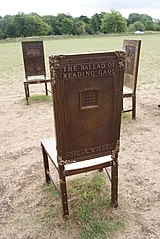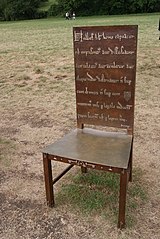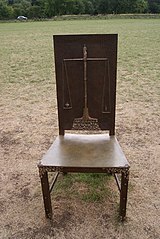The Jurors
Commissioned in 2014 by Surrey County Council and the National Trust, it comprises 12 high-backed bronze chairs placed in a grassy meadow, arranged in a rectangular formation to face inwards as if around a table, with one chair at each end and five along each side. Each chair measures 123 cm × 61 cm × 57 cm (48 in × 24 in × 22 in), and the installation covers an area of 4 m × 19 m (13 ft × 62 ft).
The surfaces of each chair are decorated with images and symbols representing freedom, the rule of law, and human rights, clockwise from one end:
| Chair | Inside | Outside |
|---|---|---|
| 1. | Portrait of the suffragette Lillie Lenton | A teacher and pupils in a classroom discussing the United Nations Convention on the Rights of the Child |
| 2. | A representation of the Exxon Valdez oil spill | Cover art for a book of Oscar Wilde's poem The Ballad of Reading Gaol, designed as a prison door |
| 3. | Clause 39 of Magna Carta, no one is to be imprisoned without lawful judgement of his peers | Portrait of the Indian lawyer Cornelia Sorabji |
| 4. | The 1920 Blind March, under the banner "Justice not Charity" | Indigenous land claims, represented by an Amerindian headdress, a forest and a river with gold nuggets |
| 5. | Portrait of an African-American woman commemorating Phillis Wheatley and Mary Prince | 1861 emancipation of the Russian serfs, and the Alexander Nevsky Cathedral, Moscow |
| 6. | Portable charkha (spinning wheel) designed by Mahatma Gandhi, and represented on the flag of India | Harvey Milk's loudhailer |
| 7. | Shredding of documents, such as Stasi files | The barred door of Nelson Mandela's prison cell |
| 8. | Two representations of freedom of speech | Portraits representing The Disappeared |
| 9. | Representations of the Golden Rule, with the phrase "do as you would be done by" or "treat others as you would wish to be treated yourself" in 14 languages | Refugees on a boat, and the names of vessels involved in important cases establishing maritime law |
| 10. | Chinese characters for the Confucian principles of Ren, Li, and Yi (humaneness, ritual, and justice) | Hollow boab tree, used to imprison Aboriginal Australians in the 1890s |
| 11. | Ancient Egyptian scales with the head of Maat, goddess of truth and justice and an early personification of Lady Justice, weighing a heart against a feather | The Zong slave ship, with its sails marked with the Adinkra symbols "Epa", of overlapping diamonds symbolising handcuffs, representing captivity, law and justice |
| 12. | The house in Yangon, Burma, where Aung San Suu Kyi was held under house arrest | The xiezhi, a legendary horned creature that is a symbol of justice and law in Chinese mythology |
[1] - detailed photos of chairs
The decorations cast into the chairs also include garlands of flowers, as a reference to the Victorian language of flowers, including coltsfoot, black-eyed Susan and horse chestnut for aspects of justice, and hops for injustice; images of ermine as a reference to the traditional robes of English judges; and keys to prison cells, including a key to the Bastille which was given to George Washington by the Marquis de Lafayette in 1790.
Locke deliberately avoided representing a "collection of heroes", and intended his 24 selected scenes to provoke reflection and debate. Locke considers that the artwork is only completed when each chair is occupied by people discussing the issues depicted.
It was dedicated on 15 June 2015, at a ceremony attended by Prince William, Duke of Cambridge. The ceremony included a dramatised performance of the poem "Or In Any Other Way" by Owen Sheers, in which twelve actors emerged from the crowds to recite a stanza each, and then took a place on one of the chairs.
-
Outside of chair 2, with a prison door as cover art for Oscar Wilde's poem The Ballad of Reading Gaol
-
Inside of chair 3, with clause 39 of Magna Carta,
-
Inside of chair 11, with the scales of Maat
References
- The Jurors by Hew Locke, at Runnymede and Ankerwycke, National Trust
- What does The Jurors represent?, National Trust
- The dedication of The Jurors at Runnymede, National Trust
- The Jurors artwork at Runnymede, Exploring Surrey's Past
- The Jurors, an artwork by Hew Locke for Runnymede - Lillie Lenton, Exploring Surrey's Past
- The Jurors, an artwork by Hew Locke for Runnymede - Clause 39 of Magna Carta, Exploring Surrey's Past
- The Jurors, an artwork by Hew Locke for Runnymede - freedom of speech, Exploring Surrey's Past
- Hew Locke, Exploring Surrey's Past
- The Jurors, hewlocke.net
- Magna Carta: Prince William unveils Hew Locke's new artwork The Jurors at Runnymede, SurreyLive, 16 June 2015
- The Jurors and the Queen: Memorialising Magna Carta at Runnymede, Steven Franklin, 18 October 2017
- Hew Locke, The Jurors, situations.org.uk
- [2], detailed photos of chairs


